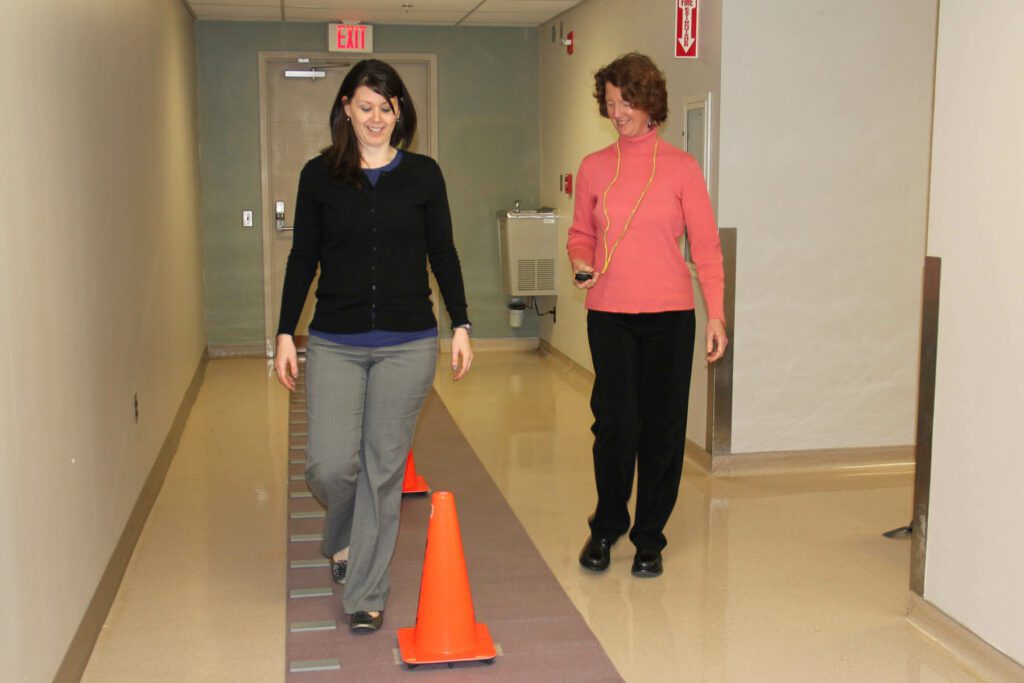Dynamic Gait Index: 8 Tasks to Evaluate Your Balance
The Dynamic Gait Index (DGI) is a clinical tool used to evaluate a person’s ability to perform various functional tasks related to walking. It is commonly used by physical therapists and other healthcare professionals to assess and track a patient’s progress in improving their mobility and balance.
The DGI was developed in 1997 by a team of researchers led by Sue Whitney, PT, PhD, at the University of Pittsburgh. The team developed the DGI to address the limitations of existing gait assessment tools that were primarily focused on measuring gait speed and distance. The DGI was designed to be a more comprehensive tool that could evaluate a person’s ability to perform more complex tasks that require good balance, coordination, and flexibility.
The DGI consists of eight tasks that simulate real-world situations that require walking and changing direction, including:
- Walking on a level surface
- Walking while changing speed
- Walking while turning the head side to side
- Walking while turning the head up and down
- Walking while stepping over an obstacle
- Walking while picking up an object from the floor
- Walking while turning around in a circle
- Walking while stepping over an obstacle and turning around in a circle
Each task is scored on a scale of 0 to 3, with 3 indicating that the task was completed without any difficulty, and 0 indicating that the task could not be completed. The maximum score that can be obtained on the DGI is 24.
The DGI has been shown to be a reliable and valid tool for assessing gait and balance in various populations, including older adults, individuals with Parkinson’s disease, and individuals recovering from stroke or other neurological conditions.
The DGI can provide valuable information about a person’s functional abilities and can help healthcare professionals develop appropriate treatment plans. For example, a person who scores low on the DGI may be at a higher risk for falls and may require interventions to improve their balance and coordination. In contrast, a person who scores high on the DGI may be able to safely perform more complex tasks that require good balance and coordination.

The DGI is typically administered in a clinical setting, with the person being assessed wearing their regular footwear and using any assistive devices they would normally use. The evaluator provides verbal cues as needed to help the person complete each task.
In addition to providing valuable information about a person’s functional abilities, the DGI can also be used to track a person’s progress over time. A person who completes the DGI at multiple points in their rehabilitation may be able to see improvements in their gait and balance, which can be motivating and provide important feedback to healthcare professionals.
It is important to note that the DGI is just one tool that healthcare professionals can use to evaluate gait and balance. Other tools, such as the Berg Balance Scale or the Tinetti Performance-Oriented Mobility Assessment, may also be used depending on the person’s specific needs and goals.
In conclusion, the Dynamic Gait Index is a valuable clinical tool for assessing a person’s ability to perform functional tasks related to walking. It can provide valuable information about a person’s gait and balance and can help healthcare professionals develop appropriate treatment plans. If you are a person who has concerns about your mobility or balance, or if you are a healthcare professional who works with individuals who have mobility or balance concerns, the DGI may be a useful tool to consider. It is important to work with a qualified healthcare professional who can administer and interpret the results of the DGI to ensure that you receive the best care possible.
The Dynamic Gait Index Test
Walk on a level surface
The person is instructed to walk 20 feet on a level surface at their normal pace. The grading criteria are as follows:
- 3 points: Able to walk 20 feet without any loss of balance or need for support.
- 2 points: Able to walk 20 feet but needs to use a device (e.g., cane) for support.
- 1 point: Able to walk 20 feet with moderate loss of balance or needs contact guard assistance.
- 0 points: Unable to complete the task.
Walk while changing speed
The person is instructed to walk 20 feet, changing their speed from slow to fast and then from fast to slow again. The grading criteria are as follows:
- 3 points: Able to walk 20 feet and change speed smoothly without any loss of balance or need for support.
- 2 points: Able to walk 20 feet and change speed, but needs to use a device (e.g., cane) for support.
- 1 point: Able to walk 20 feet and change speed, but with moderate loss of balance or needs contact guard assistance.
- 0 points: Unable to complete the task.
Walk while turning head side to side
The person is instructed to walk 20 feet while turning their head side to side in time with a metronome set at 1 beat per second. The grading criteria are as follows:
- 3 points: Able to walk 20 feet and turn head smoothly without any loss of balance or need for support.
- 2 points: Able to walk 20 feet and turn head, but needs to use a device (e.g., cane) for support.
- 1 point: Able to walk 20 feet and turn head, but with moderate loss of balance or needs contact guard assistance.
- 0 points: Unable to complete the task.
Walk while turning head up and down
The person is instructed to walk 20 feet while turning their head up and down in time with a metronome set at 1 beat per second. The grading criteria are as follows:
- 3 points: Able to walk 20 feet and turn head smoothly without any loss of balance or need for support.
- 2 points: Able to walk 20 feet and turn head, but needs to use a device (e.g., cane) for support.
- 1 point: Able to walk 20 feet and turn head, but with moderate loss of balance or needs contact guard assistance.
- 0 points: Unable to complete the task.
Walk while stepping over an obstacle
The person is instructed to walk 20 feet and step over a 6-inch high obstacle placed in their path. The grading criteria are as follows:
- 3 points: Able to step over the obstacle without any loss of balance or need for support.
- 2 points: Able to step over the obstacle, but needs to use a device (e.g., cane) for support.
- 1 point: Able to step over the obstacle, but with moderate loss of balance or needs contact guard assistance.
- 0 points: Unable to complete the task.
Walk while picking up an object from the floor
The person is instructed to walk 20 feet and pick up a pencil placed on the floor in front of them. The grading criteria are as follows:
- 3 points: Able to pick up the object from the floor without any loss of balance or need for support.
- 2 points: Able to pick up the object from the floor, but needs to use a device (e.g., cane) for support.
- 1 point: Able to pick up the object from the floor, but with moderate loss of balance or needs contact guard assistance.
- 0 points: Unable to complete the task.
Walk while turning around in a circle
The person is instructed to walk 360 degrees in a circle to the right and then 360 degrees in a circle to the left. The grading criteria are as follows:
- 3 points: Able to turn around in a circle without any loss of balance or need for support.
- 2 points: Able to turn around in a circle, but needs to use a device (e.g., cane) for support.
- 1 point: Able to turn around in a circle, but with moderate loss of balance or needs contact guard assistance.
- 0 points: Unable to complete the task.
Walk while stepping over an obstacle and turning around in a circle
The person is instructed to walk 20 feet, step over a 6-inch high obstacle, turn 180 degrees, and then walk back to the starting point. The grading criteria are as follows:
- 3 points: Able to complete the task without any loss of balance or need for support.
- 2 points: Able to complete the task, but needs to use a device (e.g., cane) for support.
- 1 point: Able to complete the task, but with moderate loss of balance or needs contact guard assistance.
- 0 points: Unable to complete the task.
During each task, the evaluator provides verbal cues as needed to help the person complete the task safely and correctly. Each task is scored on a scale of 0 to 3 based on the person’s performance, with 3 indicating that the task was completed without any difficulty and 0 indicating that the task could not be completed. The maximum score that can be obtained on the DGI is 24.
